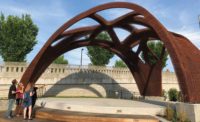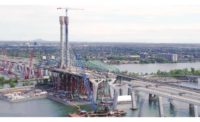While “fulfillment centers” and other e-commerce logistic facilities drive a hot market for the manufacturing sector, traditional construction methods such as tilt-up concrete panels are being pushed to ever-greater heights. At a recent project in Tulsa, Okla., contractor Clayco oversaw installation of tilt-up composite panels that reached 81 ft in height, using an unusual brace and a lot of careful pre-planning.
“It was originally designed in precast, but they couldn’t do tall enough panels,” says Jeff Cannedy, Clayco project executive, who worked on what the confidential e-commerce owner called Project Dylan. The steel-frame building was also too tall for stacked panels to be used, he says. Lower panels could be braced to the ground, but the upper panels would have to be held up by a crane until the steel connections were made, which the schedule did not allow for. “But a full-height panel can be braced to the ground and not just the steel,” says Cannedy. The resulting tilt-up composite panels are up to 81-ft tall and 13 in. thick, with two 5-in. concrete layers with a 3-in. layer of insulation in the core.
The owner’s demands drove the unusual approach, says Karen Hand, structural engineer with the project’s structural wall panel designer, Needham DBS. “The reason we have these panels so tall is many e-commerce logistic centers are going toward having multifloor spaces to increase their efficiencies,” she says.
This is a shift from the designs older logistics facilities in the Midwest, which were traditionally more horizontally laid out to accommodate traditional conveyor systems, notes Hand. But modern e-commerce giants are leaning more toward building large, open vertical spaces better suited for robots to move up and down unimpeded, she says.
The key component that allowed the tilt-up process to work was a Super 62 brace, anchored to the ground and to an embedded insert in the panel. At 62 ft long, 9 in. in dia. and 950 lb, it’s no ordinary brace. “The Super 62 can accommodate panels up to 90 ft tall. It’s really new to the [tilt-up] industry to go to those heights,” says Mike Wolstenholme, project executive with brace manufacturer Meadow Burke, part of the design team. “There were a lot of unique challenges on this project,” he says. “This [Super 62] brace was created just for this project, it was the first project in the country that a brace of this nature has been used.”
Some of the lessons from Project Dylan are being applied on a similar project for the same confidential owner in Beaumont, Calif. With seismic codes and regional differences in construction methods taken into account, the designers went with a modified version of the massive tilt-up panels used on the Tulsa project. On the Beaumont job, referred to by the owner as Project Cherry, structural wall panel designer HSA & Assoc. went with a load-bearing tilt-up panel that allowed for the perimeter steel to be taken out of the design used in Tulsa. “It’s the same building, same design, just a different [structural] design solution,” explains Cannedy.
Seismic codes required other changes to the design by HSA, including vertical pilasters along the sides of the 75-ft-tall, tilt-up concrete panels to create a stiffer leg along the edge of the panels, at thicknesses up to 30 in. During the tilt-up process the team used Super 52 braces from Meadow Burke, which braced the panels from the inside rather than outside due to uneven grades outside the site. Having to work without the perimeter steel meant the tilt-up operation came with extra work to make sure connections were properly made. “Every panel that goes up we hold our breath for a minute,” says Chris Armstrong, vice president of Guy Yocum Construction, which served as concrete contractor on Project Cherry.
“The thing about this is that the height limitation [for concrete tilt-up] has been overcome,” says Clayco’s Cannedy. “Panels in general have never extended much beyond 60 ft to 65 ft, but both of these projects have 70-ft to 85-ft panels. You’ll see the limitations being overcome in projects across the country.”








Post a comment to this article
Report Abusive Comment